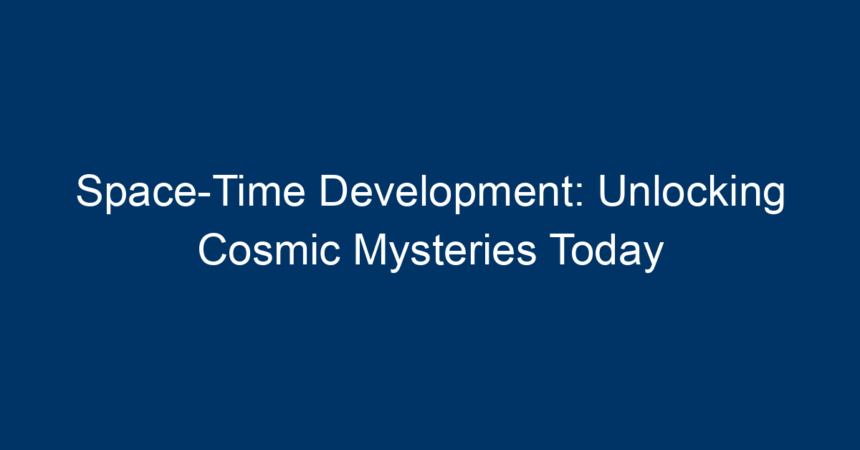The universe is a vast, mysterious entity that has piqued human curiosity for centuries. At the heart of astrophysics lies an intricate concept known as space-time development. This term not only encapsulates the relationship between time and space but also serves as the cornerstone of our understanding of the cosmos. As we delve deeper into the complexities of the universe, space-time development continues to unveil remarkable insights that challenge our perceptions and stimulate our imaginations. In this article, we will explore the fundamental concepts of space-time, the latest advancements in this field, and the implications of these discoveries on our understanding of the universe.
What is Space-Time?
The Basic Concept
Space-time is a four-dimensional continuum combining the three dimensions of space—length, width, and height—with the dimension of time. The Einstein’s theory of relativity revolutionized our understanding of these two components, suggesting that time is not a separate entity from space but rather intertwined with it. This means that the fabric of the universe is not merely a stage for events to unfold but a dynamic participant in the cosmic drama.
Space-Time and Gravity
One of the most intriguing aspects of space-time development is the relationship between gravity and the curvature of the space-time fabric. According to Einstein’s general theory of relativity, massive objects like stars and planets warp the space-time around them. This warping creates gravitational fields, pulling smaller objects toward them. Thus, rather than viewing gravity as a force, it can be understood as the effect of the curvature of space-time.
The Evolution of Space-Time Development
Historical Milestones
The journey into understanding space-time has been a remarkable one. Here are some of the pivotal milestones:
-
Galileo’s Insights (17th Century): Galileo advocated for the notion of relative motion, laying the groundwork for later theories about time and space.
-
Newtonian Mechanics (17th Century): Isaac Newton’s laws of motion and universal gravitation presented a framework for understanding the physical universe, albeit without the interplay of time.
-
Einstein’s Theory of Special Relativity (1905): This introduced the concept that the laws of physics are the same for all non-accelerating observers and that the speed of light is constant, regardless of the motion of the observer or light source.
- General Relativity (1915): This expanded on his earlier work, establishing a new understanding of gravity and how it interacts with the fabric of space-time.
Recent Advances
In the last few decades, scientists have made significant strides in the realm of space-time development. One of the most exciting advancements is the observation of gravitational waves, ripples in space-time caused by massive cosmic events like colliding black holes. First detected in 2015, these waves provide a new way of observing the universe, opening doors to explore previously unreachable cosmic phenomena.
Moreover, theoretical developments like string theory and loop quantum gravity are pushing the boundaries of our understanding. These frameworks attempt to unify general relativity and quantum mechanics, potentially providing a complete theory of the universe.
The Role of Quantum Mechanics
Quantum Entanglement and Space-Time
One of the most baffling aspects of quantum mechanics is entanglement, where particles become interconnected in such a way that the state of one immediately influences the state of another, regardless of the distance separating them. This phenomenon poses profound questions about space and time. Does entanglement suggest a deeper layer of reality that transcends the conventional understanding of space-time?
Researchers are actively exploring theories that integrate quantum mechanics with space-time development. For instance, concepts like the holographic principle suggest that the universe’s three-dimensional properties could be an illusion, represented by information on a two-dimensional surface. Such theories challenge our traditional perceptions and emphasize the need for a new understanding of reality.
Black Holes and Space-Time
Black holes are perhaps the most fascinating examples of the extreme distortions in space-time. When a star collapses under its own gravity, it creates a singularity, an infinitely dense point where the laws of physics as we know them break down. The event horizon, the boundary beyond which nothing can escape, serves as a stark reminder of the extreme warping of space-time. Studying black holes offers invaluable insights into space-time development and the fundamental laws governing the universe.
Implications for Humanity
The Search for Extraterrestrial Life
Understanding space-time development is not just a scientific pursuit; it carries implications for humanity’s future. As we refine our grasp of cosmic phenomena, the search for extraterrestrial life becomes more tangible. Knowing how different gravitational fields and space-time curvatures affect the potential for life on other planets can help shape future explorations.
Advancements in Technology
Technological advancements stemming from space-time research have already manifested in various fields. Satellite technology, GPS systems, and even new medical imaging techniques owe part of their existence to theories rooted in space-time development. These innovations continue to evolve, improving our everyday lives and enhancing how we understand our world.
Conclusion: Harnessing the Power of Space-Time Development
The exploration of space-time development is more than an academic endeavor; it’s an odyssey that expands the very boundaries of human knowledge. Whether through the detection of gravitational waves or the exploration of deep-space phenomena, our understanding of the universe’s structure and fabric is evolving rapidly.
Take Action: Getting Involved in Space-Time Education
To contribute to this exciting field:
-
Stay Informed: Follow reputable science news sources and journals that cover the latest research on space-time development.
-
Participate in Discussions: Engage in forums, webinars, and local meetups that focus on astrophysics and cosmology.
- Support Science Education: Contribute to educational programs and initiatives that foster interest in physics and space science for future generations.
The cosmos is a vast book waiting to be read, and each discovery in space-time development adds a new chapter to our understanding of existence. The keys to unlocking these cosmic mysteries lie in curiosity, inquiry, and the relentless pursuit of knowledge. Join the adventure, as we stand on the precipice of a new era in our understanding of space, time, and the universe.




